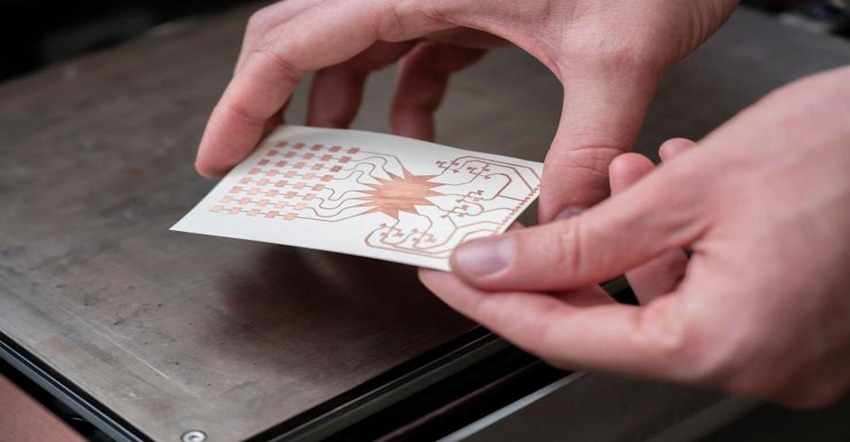Will 5G Technology Users Really be Able to Seize Useful Power From the Airways?
Connected devices may one day use the energy created by technology from Georgia Tech researchers instead of batteries.
April 24, 2021

Most already know of the promise of 5G wireless technology to boost the speed and transfer of mobile data. Now researchers at the Georgia Institute of Technology have discovered another use for the technology—turning the over-capacity of 5G networks into “a wireless power grid” for the Internet of Things (IoT).
Researchers have developed a special antenna system that for the first time can harvest millimeter radio waves in the 28-GHz band, they said. The antenna—called a flexible Rotman lens-based rectifying antenna, or rectenna—and the related system has some particular modifications that make it suited to this purpose, they said.
The technology has the potential to create an alternative power source to batteries for the myriad connected devices that comprise the IoT, said Jimmy Hester, senior lab advisor on the research team. He also is CTO and co-founder of Atheraxon, a Georgia Tech spinoff developing 5G radio-frequency identification (RFID) technology.
“I’ve been working on energy harvesting conventionally for at least six years, and for most of this time, it didn’t seem like there was a key to make energy harvesting work in the real world because of FCC limits on power emission and focalization,” he explained in a press statement. “With the advent of 5G networks, this could actually work, and we’ve demonstrated it. That’s extremely exciting — we could get rid of batteries.”
To harvest enough energy from radio waves to supply low-power devices—like sensors and other IoT devices—requires a large-aperture antenna. However, historically these antennas have a narrowing field of view, which limits their operation if dispersed from a 5G base station, researchers said.
The team in Georgia Tech’s ATHENA lab solved this problem by developing a system with a wide-angle of coverage, said ATHENA senior researcher Aline Eid. ATHENA was created to advance and develop novel technologies for electromagnetic, wireless, RF, millimeter-wave, and sub-terahertz applications.
Ubiquitous Power
5G networks eventually will have broad coverage around the world, especially in urban areas. Researchers envision that with their solution, “you can replace millions, or tens of millions, of batteries of wireless sensors,” said Emmanouil (Manos)Tentzeris, a professor in flexible electronics at Georgia Tech.
This will especially be true for smart city and smart agricultural applications that use sensors that can be powered by harvesting energy from 5G networks, he said.
The reason 5G systems can provide this energy is that the FCC has authorized 5G to focalize power much more densely compared with previous generations of wireless networks. Today’s 5G was designed with high-bandwidth communication in mind, which means power that would otherwise be wasted can be harvested for other uses, researchers said.
In fact, Tentzeris predicts that power as a service will be the next big application for the telecom industry, offering power on demand “over the air,” he said.
Multi-View Perspective
The use of a Rotman lens is key to creating the functionality possible to achieve this type of broad energy harvesting from the millimeter waves, researchers said. The Rotman lens acts like an optical lens, providing six fields of view at the same time in a pattern shaped like a spider.
To take advantage of this wide perspective, researchers created a structure that can map a set of selected radiation directions to an associated set of beam-ports, with the lens used as an intermediate component between receiving antennas on one side and rectifiers for 5G energy harvesting on the other, they said.
With this set-up, all the electromagnetic energy collected by the antenna arrays from one direction is combined and fed into a single rectifier, maximizing its efficiency, Hester said.
“With this innovation, we can have a large antenna, which works at higher frequencies and can receive power from any direction,” he said in a press statement. “It’s direction-agnostic, which makes it a lot more practical.”
To fabricate the system, researchers used in-house additive manufacturing to print the palm-sized mm-wave harvesters on various flexible and rigid substrates. This facilitated cost-effective production and will extend manufacturing to a broad range of users, platforms, frequencies, and applications, researchers said.
The team published a paper on their work in the journal Scientific Reports.
The approach researchers took to develop the system addresses the trade-off between rectenna angular coverage and turn-on sensitivity with a structure that merges radio frequency (RF) and direct current (DC) combination techniques. This design point allows for a system that has both high gain and large beamwidth, researchers said.
In demonstrations, Georgia Tech’s technology achieved a 21-fold increase in harvested power compared with a comparable counterpart—which is referenced in the paper. At the same time, the system maintained identical angular coverage, researchers said.
Elizabeth Montalbano is a freelance writer who has written about technology and culture for more than 20 years. She has lived and worked as a professional journalist in Phoenix, San Francisco, and New York City. In her free time, she enjoys surfing, traveling, music, yoga, and cooking. She currently resides in a village on the southwest coast of Portugal.
About the Author(s)
You May Also Like



